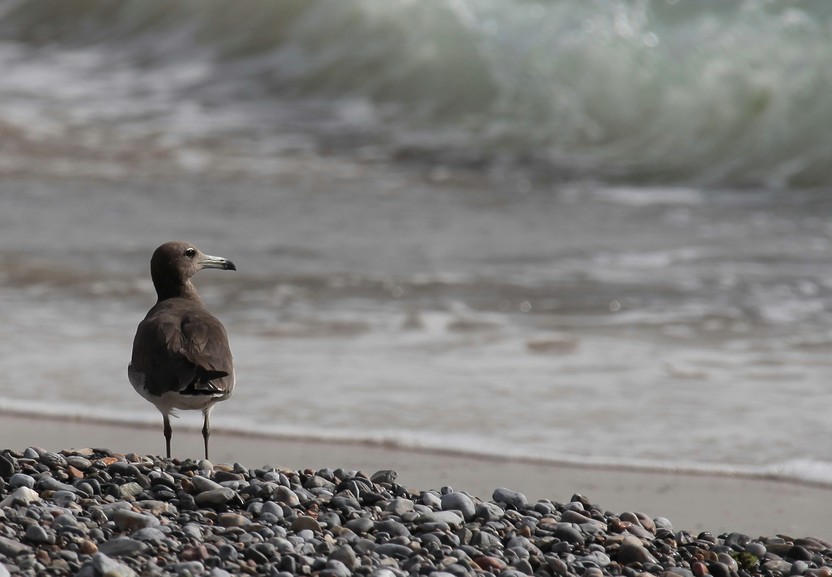ICHTHYAETUS HEMPRICHII - (BRUCH, 1853)
Goéland de Hemprich, Sooty Gull (en), Gabbiano di Hemprich (it), Gaviota Cejiblanca (es), Hemprichmöwe (al), Hemprichs meeuw (nl).
Le Goéland de Hemprich est une espèce d'oiseau appartenant à la famille des Laridae. Il est présent au Moyen-Orient, en Arabie et en Afrique de l'Ouest. Son nom commémore le naturaliste allemand, Wilhelm Hemprich (1796-1825), mort durant une expédition en Érythrée.
Synonyme
Larus hemprichii
-----------------------------------------------
The Sooty Gull (Ichthyaetus hemprichii) is a species of gull in the Laridae family. It is found in Bahrain, Djibouti, Egypt, Eritrea, India, Iran, Israel, Jordan, Kenya, Lebanon, Maldives, Mozambique, Oman, Pakistan, Qatar, Saudi Arabia, Somalia, Sri Lanka, Sudan, Tanzania, United Arab Emirates, and Yemen. As is the case with many gulls, it has traditionally been placed in the genus Larus.
Justification
This species has a very large range, and hence does not approach the thresholds for Vulnerable under the range size criterion (Extent of Occurrence <20,000 km2 combined with a declining or fluctuating range size, habitat extent/quality, or population size and a small number of locations or severe fragmentation). Despite the fact that the population trend appears to be decreasing, the decline is not believed to be sufficiently rapid to approach the thresholds for Vulnerable under the population trend criterion (>30% decline over ten years or three generations). The population size is very large, and hence does not approach the thresholds for Vulnerable under the population size criterion (<10,000 mature individuals with a continuing decline estimated to be >10% in ten years or three generations, or with a specified population structure). For these reasons the species is evaluated as Least Concern.
Distribution and population
The Sooty Gull can be found in the Red Sea and Gulf of Aden, in the Persian Gulf and Gulf of Oman, east to south Pakistan and south to northern Kenya (Kiunga Islands).
Trend justification
Although Wetlands International consider the population to be increasing, the population is suspected to be in decline owing to unsustainable levels of exploitation (del Hoyo et al. 1996).
Ecology
Behaviour This species is a partial migrant or nomad, most populations undergoing southern post-breeding dispersal movements, in September-November. Some populations may also be sedentary (many remain in the Red Sea area all year round). The species breeds in the Summer (usually between April and October), and usually nests colonially (e.g. in small loose colonies on the larger islands in the Gulf of Aden and Red Sea), or occasionally solitarily (e.g. in Africa) with pairs per island often amidst colonies of other species. It usually forages alone, but is highly gregarious at times. Habitat The species inhabits coasts and inshore islands and is hardly ever seen inland, or at freshwater. It is found at harbours and ports, and forages inshore, in intertidal zones, and up to 10 km beyond reefs, rarely extending up to 140 km offshore. It nests on coastal or inshore coral islands preferring smaller outer islands of old coral that are sparsely vegetated, rocky and sandy, preferably protected from the ocean by live reef. Diet Its diet consists mainly of dead fish and fishermen's offal, as well as tern eggs and chicks, the eggs of White-eyed Gull Larus leucophthalmus, turtle hatchlings, prawns and small fish. It poses a threat to other species as it is a serious local predator of eggs and chicks in colonies of other seabirds. Breeding site The nest is a scrape or depression in bare coral (Kenya), under mangrove bushes on a bed of leaves, under Suaeda bushes in loose sand (Somalia), or under low hanging coral (Red Sea), on exposed promontories. The species usually nests colonially but is more of a solitary nester in Africa, with pairs spaced as far apart as possible.
Threats
This species is threatened by oil exploration (e.g. pollution from future oil spills, future land reclamation for oil prospecting in the Gulf region, and disturbance to breeding birds from future oil drilling in Tanzania). It is also threatened by human exploitation, in particular egg collection from nesting colonies.
